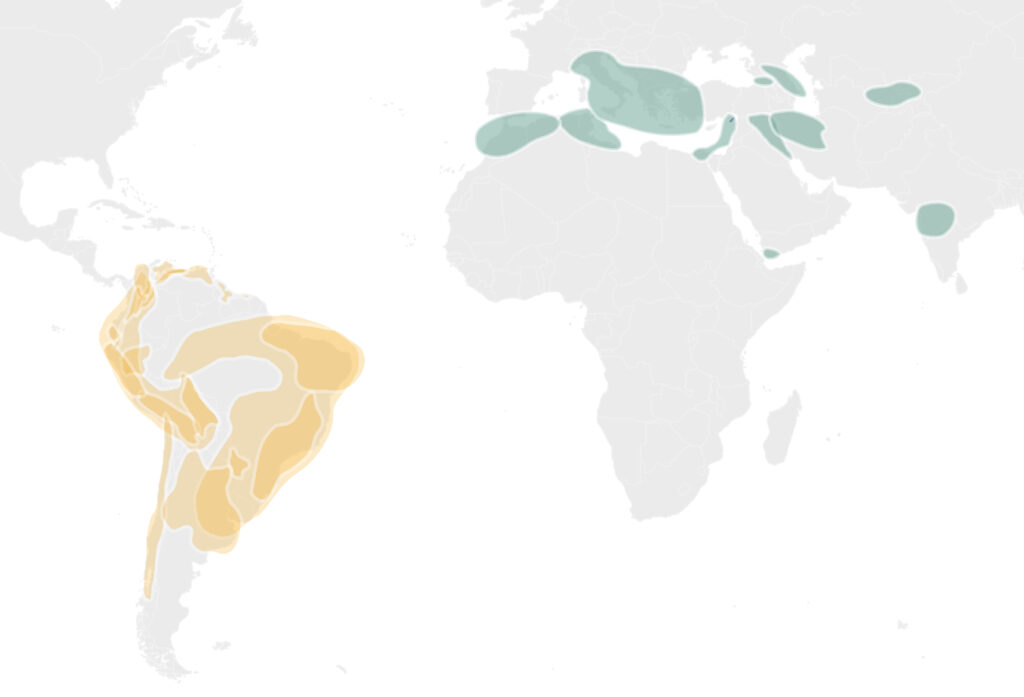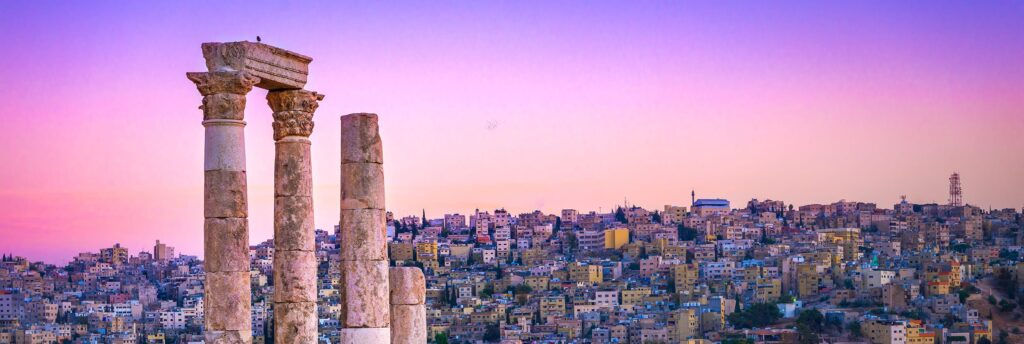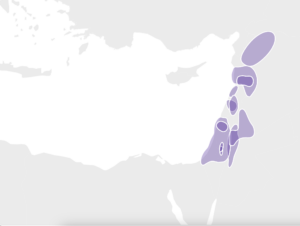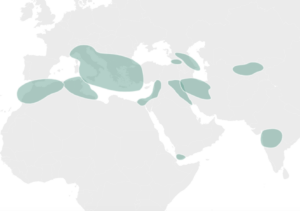
23andMe has added 58 new genetic groups in South America, North Africa, and the Middle East, providing finer detail for customers with roots in these regions.
The new update improves 23andMe’s ancestry reports and features 21 new Indigenous American Genetic Groups in South America and 26 new Genetic Groups for customers with roots in the Levant—a region encompassing modern-day Palestine, Lebanon, Syria, Jordan, and Israel.
In addition, the update includes 11 new Genetic Groups for customers with Sephardic or Mizrahi ancestry, connecting them to communities in North Africa, Central Asia, India, Iran, Iraq, and Southern Europe, including parts of Turkey and Greece.

23andMe Research Unlocks New Discoveries
Over the past few years, 23andMe scientists have developed new methods to detect distant relatedness between people with greater accuracy. They have also created tools to identify clusters of related individuals using techniques that do not rely on geopolitical borders.
• Palestine, Israel & Northwestern Jordan — Shared ancestors with people from Palestine, Israel, and Jordan, many of whom identify as Muslim.
• Palestine and Israel — Shared ancestors with people from parts of Israel and Palestine, particularly from the West Bank. Many people in this Genetic Group identify as Christian.
• Central West Syria — Shared ancestors with people from Homs, Syria, and the nearby Wadi al-Nasara—a region west of Homs in Syria’s Coastal Mountain range with a significant Christian population.
• Northern Levant — Shared ancestors with people from Lebanon and Syria, many identifying as Muslim or Druze.
• Southern Beqaa Valley and Greater Damascus — Shared ancestors with people from Damascus, Syria, and Lebanon’s Beqaa Valley, though people in this Genetic Group report ancestry from as far west as Beirut. Many people in this Genetic Group identify as Christian.
• Northwestern Lebanon — Shared ancestors with people from northwestern Lebanon—between Beirut and Tripoli, from the slopes of Mount Lebanon to the Mediterranean Sea. Many people in this Genetic Group identify as Maronite Catholic.
• Northwestern Jordanian Highlands — Shared ancestors with people from the highlands of northwestern Jordan, particularly from the hilly terrain of Jordan’s capital, Amman. Many people in this Genetic Group identify as Christian, specifically the denominations that include Greek Orthodox, Roman Catholic, and Armenian Orthodox.
• Greater Ramallah — Shared ancestors with people from the Central Highlands of Palestine in the West Bank. Most people in this Genetic Group identify as Palestinian Christians and report recent ancestry from Ramallah.
• Lower Galilee — Shared ancestors with people from Israel’s Lower Galilee (Al-Jalil) region. Many people in this Genetic Group identify as Palestinian Christians.
• Greater Bethlehem — Shared ancestors with people from the central and southern highlands of Palestine in the West Bank. Many people in this Genetic Group identify as Palestinian Christians.
• Highlands of Palestine and the Southern Coastal Plain — Shared ancestors with people from the hilly terrain of the West Bank and from the southern portion of the Levant coastal plain, which includes parts of central Israel and the Gaza Strip. People in this Genetic Group typically report recent ancestry from Al-Khalil/Hebron, Al-Quds/Jerusalem, or Nablus further north, and many identify as Muslim.
• Sawad al-Urdunn and Galilee — Shared ancestors with people from the Galilee (Al-Jalil) region in northern Israel and from the northernmost part of the Jordanian Highlands, roughly between the Yarmouk and Zarqa rivers — a region known in modern times as the Sawad al-Urdunn and historically known as Gilead. Some people in this Genetic Group identify as Palestinian and Muslim.
• Southern Plain of Sharon and Central Highlands of Palestine — Shared ancestors with people from the southern Plain of Sharon in Israel and the Central Highlands of Palestine, some of whom identify as Muslim.
• Northwestern Highlands of Palestine and Northern Plain of Sharon — Shared ancestors with people from the northwestern highlands of Palestine, parts of the Jezreel Valley, and the Plain of Sharon in northern Israel, some of whom identify as Muslim.
• Central Highlands of Palestine — Shared ancestors with people from the Central Highlands of Palestine, many of whom identify as Muslim.
• Greater Damascus and the Orontes River Valley — Shared ancestors with people from Damascus and the Barada River valley at the southern end of the East Lebanon Mountains in Syria, as well as from the Orontes (Asi) River valley further north, and many people in this Genetic Group identify as Muslim.
• Aleppo Plateau — Shared ancestors with people from Aleppo/Halab and the northern foothills of Syria’s Coastal Mountains, also known as the Ansarieh, Nusayriyah, or Alawite Mountains. People in this Genetic Group may trace their recent ancestry to the early 20th-century migration of Armenians into northern Syria during the Armenian Genocide.
• Southern Lebanon — Shared ancestors with people from southern Lebanon, particularly from the highland region, often referred to as Jabal Amel. Most people in this genetic group have recent ancestry from Lebanon’s southernmost governorates, and many identify as Shia Muslims.
• The Hauran, Ajloun Mountains, and Mount Lebanon — shared ancestors with people from southern Syria, the eastern foothills of Jordan’s Ajloun mountains, and parts of south Mount Lebanon. The strongest ancestral connections for people in this Genetic Group are to the Hauran. Many people who match this genetic group identify as Christian.
• Zahlé and the southern Beqaa Valley Uplands — Shared ancestors with people from Zahlé and the southern uplands of the Beqaa Valley in Lebanon, many of whom identify as Christian.
• Qadisha Valley and Northern Mount Lebanon — shared ancestors with people from towns nestled in the northwestern slopes and river valleys of Mount Lebanon (also known as the Lebanon Mountains), a region with a predominantly Maronite Catholic population.
• Wadi al-Nasara and Homs — Shared ancestors with people from western Syria — many of whom identify as Christian — particularly from the greater Homs area and Wadi al-Nasara (meaning “Valley of Christians”), a region in the southern Syrian Coastal Mountains with a significant Christian population.
• Southern Beqaa Valley Lowlands — Shared ancestors with people from the Litani River Basin in the lowlands of the Beqaa Valley, one of Lebanon’s key agricultural regions. Many people in this Genetic Group identify as Sunni Muslims.
• Northern Levant Coast — Shared ancestors with people from Lebanon and Syrian coastal plains and mountain ranges. People in this Genetic Group, many of whom identify as Muslim, have significant connections to certain large coastal cities of the northern Levant with significant Sunni Muslim populations and smaller Alawite populations, including Tripoli in northwestern Lebanon and Latakia and Jableh in northwest Syria.
• Central Lebanon Coast — Shared ancestors with people from the central coast of Lebanon, particularly from Sidon (Saida) and Beirut, large coastal cities with majority Sunni Muslim populations and ancient roots.
• Druze — Shared ancestors with people from southern Mount Lebanon and Wadi al-Taym in Lebanon and from Jabal al-Druze in Syria, most of whom identify as Druze*. The Druze, a distinct ethnoreligious group with Islamic, Gnostic, Hellenistic, and other influences, emerged during the 11th century in the mountainous regions of the central Levant.
To date, those efforts have produced 249+ new “Genetic Groups” in the Americas, Africa, and Europe, and more are on the way. We could now apply these new methods to Indigenous ancestry from South America, the Levant region, and Sephardic and Mizrahi ancestry to increase specificity and deliver updated results to existing customers.
The update will be available for customers on the latest genotyping chip, V5.
The Levant
The rich history of the Levant is central to people of Christian, Druze, Jewish, and Muslim faiths, among others. The Levant comprises modern-day Lebanon, Syria, Jordan, Israel, and Palestine. Today, the area continues to be one of the most religiously diverse regions in the world.
It has also been at the crossroads of human migration between Africa and Asia for millennia. Its history is reflected in its cultural, religious, and ethnic diversity.
Ancestry Detail in the Levant

The previous 23andMe update to the Levant was in 2019, in which we introduced eight new Ancestry Composition populations in West Asia and North Africa. That update included a “Levantine” ancestry population with Palestinian, Syrian, Lebanese, Jordanian, and Druze reference individuals. Since 2019, 23andMe has also shown customers their connections to more than 30 subregions across Syria, Lebanon, and Jordan.
Changes in political borders in the Levant over the last 100 years, as well as immigration and the emergence of a new state in the region, meant that our previous methods for granular ancestry insights were more prone to error.
But thanks to the growth and diversification of the 23andMe database over time, as well as significant investments in R&D leading to improved methods, 23andMe has overcome these challenges to provide more meaningful and granular results that meet our accuracy standards.
Through this work, 23andMe scientists found that Genetic Groups in the Levant were strongly associated with the reference individuals’ self-reported religious affiliations, such as Christian, Druze, or Muslim. In fact, many Genetic Groups appeared to be geographically overlapping but, upon further investigation, were found to reflect different religious affiliations.
For example, there was one Genetic Group in Lebanon’s southern Beqaa Valley that included many reference individuals who identified as Sunni Muslim, and there was another Genetic Group in the south of Beqaa Valley that included many reference individuals who identified as Christian. Upon a deeper investigation, our research team found that the Christian-associated group included individuals who tended to live at higher elevations at the edges of the southern Beqaa Valley. In contrast, the Muslim-associated group included individuals who typically lived in the south of Beqaa Valley lowlands.
Population genetics studies have not previously described this level of population genetic structure in the Levant. This update makes 23andMe the most comprehensive test for people with Palestinian ancestry and ancestry from the larger Levant region.
This level of population genetic structure in the Levant has not previously been described in population genetics studies.
New Sephardic & Mizrahi Jewish Genetic Groups
The history of the Mizrahim and Sephardim dates back thousands of years, not only in North Africa, Southern Europe, and the Middle East but as far away as Central Asia and the Indian subcontinent. In this update, 23andMe adds 11 Sephardic and Mizrahi Genetic Groups that help customers connect with that history.

Mizrahi Jews
Mizrahi Jews are a diverse group with historical roots in the Middle East, North Africa, and Central Asia. The term “Mizrahi” is Hebrew for “Eastern,” it is used to distinguish these Jewish communities from Ashkenazi Jews, who primarily hail from Central and Eastern Europe.
The Mizrahi Jewish community includes Jews from countries such as Iraq, Iran, Yemen, Syria, Lebanon, Egypt, Morocco, Tunisia, Algeria, and other parts of the Middle East and North Africa. These communities’ distinct cultural, linguistic, and religious characteristics set them apart from Ashkenazi Jews.
Sephardic Jews
“Sephardi” refers to Jewish people with historical roots in the Iberian Peninsula, including Spain and Portugal.
The Hebrew word ‘Sepharad’ means Spain and the Jewish communities of the Iberian Peninsula flourished until the Spanish Inquisition in the late 1400s. After 1492, many were expelled, forcefully converted, or fled to North Africa, the Middle East, Eastern and Central Europe, and the Americas.
Indigenous South American Groups

The beauty, variety, and vastness of South America’s geography—encompassing massive mountain ranges, the world’s largest tropical rainforest, coastal marshes, and rolling grasslands—is reflected in the breadth and diversity of its indigenous people.
The cultures of the indigenous people of South America include a rich history that long predates the colonial era. It encompasses diverse cultures, from the Inca of the Andean highlands to the Guarani, who lived in the broad plains of what is now Paraguay, to the Arawak-Lokono people who lived in coastal communities in Guyana.
This update includes 21 different Indigenous South American Genetic Groups, representing multiple indigenous cultures with roots that sometimes overlap different geographic regions and often do not conform to current political boundaries.
• Bukharan Jews — Shared ancestors with people who identify as Bukharan Jews or Central Asian Jews, primarily from Uzbekistan and Tajikistan.
• Caucasus Jews — Shared ancestors with people from the eastern Caucasus Mountains who identify as Jewish, many of whom report speaking Judeo-Tat, Azerbaijani, Russian, or Malayalam.
• Eastern Sephardic Jews — Shared ancestors with people who identify as Sephardic, primarily from the region surrounding the Aegean Sea in Greece and Turkey, with some representation from Spain, France, Italy, and Germany.
• Western North African Jews — Shared ancestors with people who identify as Moroccan Jews and Algerian Jews or of North African Jewish descent.
• Persian Jews and Kurdish Jews — Shared ancestors with people who identify as Persian Jews, Kurdish Jews, or of Iranian Jewish descent, primarily from central or western Iran.
• Syrian Jews — Shared ancestors with people who identify as Syrian Jews or of Syrian Jewish descent, primarily from Syria, but also from Lebanon, Egypt, Israel, Mexico, and Southern Europe.
• Central North African Jews — Shared ancestors with people who identify as Tunisian Jews, Libyan Jews or of Jewish descent from Tunisia, Libya, Algeria, France, and Italy.
• Iraqi Jews — Shared ancestors with people who identify as Iraqi or Baghdadi Jews or of Iraqi Jewish descent, and some people in this Genetic Group also report ancestry from India—particularly from Mumbai and Kolkata—and Western Europe.
• Georgian Jews — Shared ancestors with people who identify as Georgian Jews, primarily from Georgia, with representation from Eastern Europe and Central Asia.
• Bene Israel — Shared ancestors with people who identify as Bene Israel, primarily from western and central India.
• Adeni Jews — Shared ancestors with people who identify as Jewish with recent ancestry, primarily from Aden, a port city in southern Yemen.
Living Analysis
23andMe’s Ancestry Composition report is a living analysis that improves as we add new reference data. This latest update is also part of a series of updates we’ve done for people with roots in other regions. It includes updates for people with African ancestry, Chinese ancestry, Indigenous Caribbean ancestry, Spanish and Portuguese ancestry, Indigenous American ancestry, and British and Irish ancestry.
As with those updates, we’ve consulted with experts on the region’s genetics, customers, and people with recent ancestry from this part of the world for feedback and input. The update reflects the careful consideration of our customers’ feedback and those discussions with third-party experts, with an eye toward scientific accuracy and cultural and political sensitivity.
We’re confident that this update will benefit many of our customers. Still, we also understand it could cause confusion among individuals whose results may not match their family history from the region. In particular, due to the complex population history of these regions, it’s possible and not unexpected that people with matches to the Levant, Sephardic, and Mizrahi Genetic Groups could identify with other religious traditions.
Find out more
23andMe customers can see their Ancestry Composition here.
Are you still waiting to be a customer? Find out more about 23andMe’s Ancestry Service and other services.
• Tupí-Guaraní Speakers — Shared ancestors with people who speak Paraguayan Guarani, Western Argentine Guaraní, Mbyá Guaraní, or Nheengatu, a Tupí language. A smaller number of people report speaking Toba Qom
• The Argentine Chaco and Pampas — Shared ancestors with people from the Gran Chaco, a semiarid lowland region encompassing much of Argentina and all of Uruguay. Indigenous groups such as the Aonikenk, Kolla, Qom, Wichí, Diaguita, Mocoví, Huarpe, and Mapuche once inhabited these lands.
• Northeastern Brazilian Plateau — Shared ancestors with indigenous groups that spoke Tupí-Guaraní languages in this region that includes the Caatinga, a semi-arid shrubland unique to Brazil.
• Southern Brazilian Highlands— Shared ancestors to indigenous people from the southern Highlands of Brazil. Some indigenous languages such as Guaraní and Kaingang are still spoken in some areas.
• Guarani — Shared ancestors to the Guaraní people in eastern Paraguay, southern Brazil, and northern Argentina. People in this Genetic Group report speaking Paraguayan Guaraní. A smaller number report speaking speaking Ava Guaraní, Western Argentine Guaraní, Mbyá Guaraní, and Eastern Bolivian Guaraní.
• Lokono-Arawak of the Guianas — Shared ancestors with people who identify as Lokono-Arawak in Guyana, Suriname, and French Guiana. People in this Genetic Group report speaking Arawak, including Wapishana. A small number of people report speaking Guyanese Creole, Warao, Bajan, and Sranan Tongo.
• Mapuche of Chile — Shared ancestors with Mapuche people in northern Chile and western Argentina. People in this Genetic Group report speaking Mapuche (Mapudungun) or Huilliche.
• Quechua and Aymara — Shared ancestors with Quechua speakers, which was historically spoken by Inca, Huanca, and Chanka peoples. While the Aymara language is distinct from Quechua, Quechua-speaking Incas would come into contact with Aymara kingdoms during military conquests.
• Northern Ecuadorian Andes — Shared Indigenous American ancestors with roots in the Chimborazo highlands, including the Andean foothills near Ecuador’s capital of Quito.
• Southern Ecuadorian Coast — Shared ancestors with people who speak Chimborazo Highland Quichua. A small number report speaking Cañar Highland Quichua.
• Southern Ecuadorian Andes — Shard ancestors with people who speak Cañar Highland Quichua. The Cañari, who lived in this region, long resisted Incan rule but were eventually conquered in the 16th century, after which they adopted a Quichua language to communicate with the Inca.
• Venezuelan Coastal Range — Shared Indigenous American ancestors with Carib and Arawak speakers who lived along what is now the Venezuelan Coastal Range, primarily in the states of Miranda and Sucre.
• Northern Venezuelan Andes and the Maracaibo Basin — Shared Indigenous American ancestors with Wayuu speakers, an Arawakan language, who lived around Lake Maracaibo.
• Southern Venezuelan Andes— Shared Indigenous American ancestors with people from what is now the Venezuelan state of Táchira. The Timoto–Cuica people historically occupied this region.
• Colombian Caribbean Coast — Shared Indigenous American ancestry with people who speak Achagua, Quechua, and Amazonic Spanish with ties to the Caribbean region of Colombia.
• Altiplano Cundiboyacense of Colombia — Shared Indigenous American ancestry with people who speak Kuna, a Chibchan language. This region is traditionally part of the territory of the Chibcha (Muisca) people.
• Colombian Central and Western Andes — Shared Indigenous America ancestry with people who speak Siriano, a Tucanoan language, and Quechua, and who historically lived in the Colombian Massif region of the Andes.
• Peruvian Amazon Basin — Shared Indigenous American ancestry with people who speak Amazonic Spanish and Quechua and trace their roots to the Peruvian Amazon.
• Northern Peruvian Andes and Chira Valley — Shared ancestry with Quechua speaking people including those who speak Corongo Ancash, Jauja Wanca, and Huaylas Ancash dialects. These individuals trace their roots to areas around what is now the city of Lima to southern Ecuador.
• Bolivian Amazon — Shared ancestry from this region of the Amazon with more than 29 indigenous groups that historically included the southernmost Arawaken speakers.
• Southern Peruvian Andes and Andean Plateau — Shared ancestry with people who speak Aymara, as well as South Bolivian Quechua, Cusco Quechua, and Ayacucho Quechua.